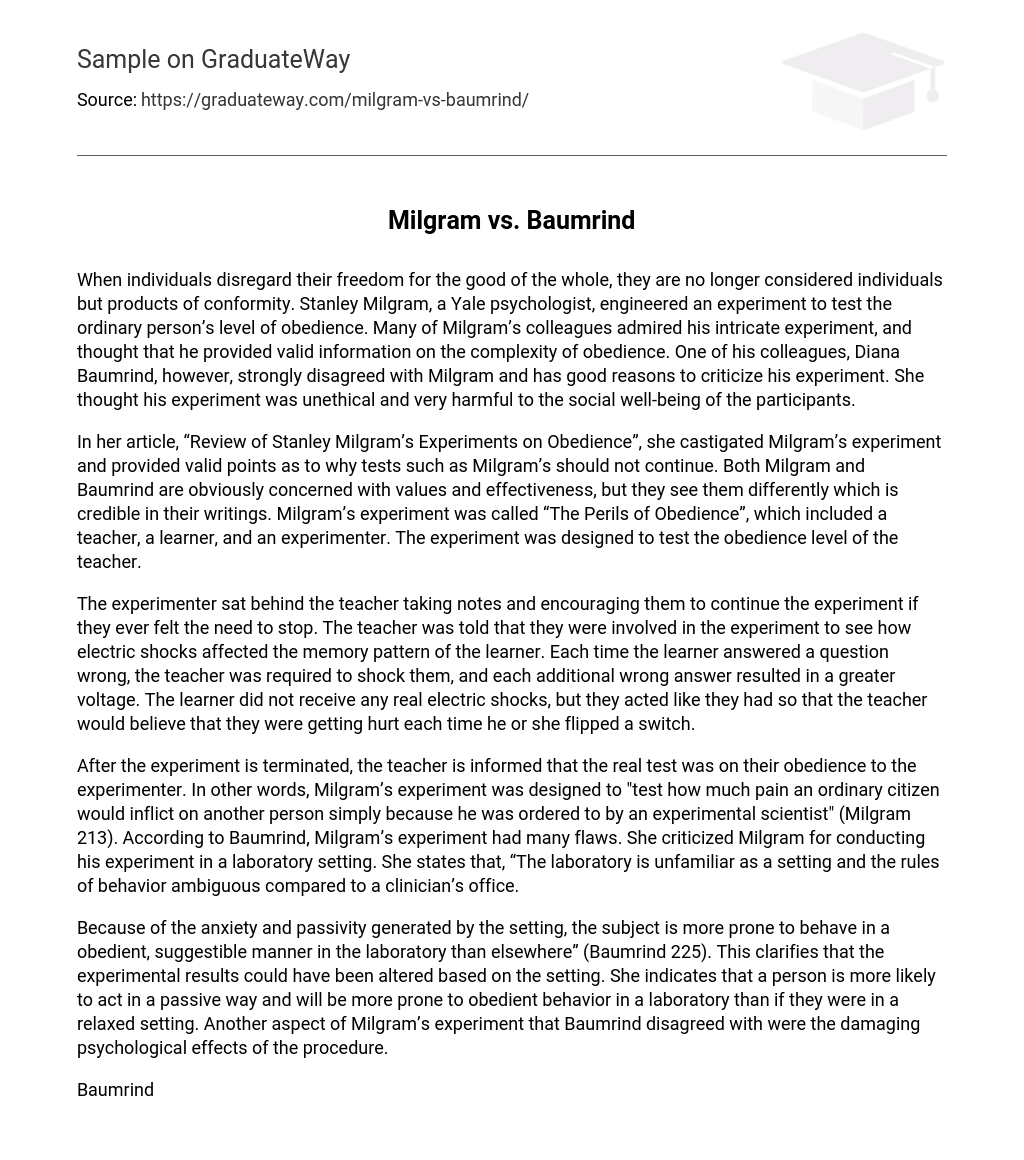When individuals sacrifice their freedom for the benefit of the collective, they lose their individuality and become conformists. Stanley Milgram, a psychologist from Yale, conducted an experiment to examine the extent of obedience in ordinary people. While many of Milgram’s peers praised his elaborate experiment and found it to offer valuable insights on obedience, one colleague named Diana Baumrind vehemently disagreed with him. She believed his experiment was unethical and posed serious harm to the participants’ social welfare.
In her article titled “Review of Stanley Milgram’s Experiments on Obedience”, she strongly criticized Milgram’s experiment and presented persuasive arguments against the continuation of such tests. Both Milgram and Baumrind share a concern for values and effectiveness but have different perspectives on these issues, as evident in their writings. Milgram’s experiment, named “The Perils of Obedience”, involved a teacher, a learner, and an experimenter. Its purpose was to assess the level of obedience displayed by the teacher.
The experimenter observed and supported the teacher throughout the experiment, encouraging them to proceed if they ever felt inclined to terminate it. The purpose of the experiment was to examine how electric shocks influenced the learner’s memory pattern. Whenever the learner provided an incorrect answer, the teacher was instructed to administer a shock, increasing the voltage for each subsequent incorrect response. Although the learner did not actually receive any electric shocks, they pretended to experience pain in order to convince the teacher that they were being harmed every time a switch was activated.
After the experiment is finished, the teacher is notified that the true purpose of the test was to examine their obedience towards the experimenter. In simpler terms, Milgram’s experiment aimed to assess the extent to which an ordinary individual would harm another person solely based on orders from a scientific researcher (Milgram 213). Baumrind, on the other hand, raised numerous objections to Milgram’s experiment. She criticized his choice of conducting the experiment in a laboratory environment and pointed out that the unfamiliarity and ambiguous rules of behavior in such a setting differ from those in a clinician’s office.
According to Baumrind (225), the subject’s behavior in the laboratory is influenced by the anxiety and passivity caused by the setting, making them more likely to act obediently and suggestibly. This suggests that the experimental outcomes may have been affected by the environment. Baumrind also points out that individuals are more prone to passivity and obedience in a laboratory compared to a relaxed setting. Additionally, she criticized Milgram’s experiment for its negative psychological consequences.
Baumrind discovered that the experiment caused severe trauma for the participant. She supports her claim by stating, “I consider the emotional distress described by Milgram to be potentially detrimental as it may lead to a change in the participant’s self-perception or their ability to trust adult figures in the future” (Baumrind 227). She argues that deceiving the participant can result in emotional distress and challenges in trusting authority figures afterwards. Baumrind further elaborates on the participant’s struggle to perform an action they know is morally wrong.
According to Baumrind (227), she illustrates the harm potential of a subject being urged to commit acts that they themselves view as unworthy during an experiment, especially when lured into such acts by someone they trust. The study participant experiences profound remorse upon realizing the potential harm they could have inflicted. Notably, the experimenter persevered with the experiment even when the teacher expressed a desire to discontinue.
He emphasized the importance of continuing until the test was finished. Baumrind argues that comparing the teacher to SS men in Nazi Germany is flawed. While both gave instructions to their “teachers” and manipulated the perception of the victims deserving their treatment, the SS men did not view their authority figures as benign researchers. According to Baumrind, the SS men considered their victims insignificant and unworthy. She points out, “He did not need to feel guilt or conflict because within his frame of reference he was acting rightly” (Baumrind 228), describing the mindset of the SS men during torture. Baumrind accuses Milgram of mistreating his participants in the experiment, stating that sociopsychological studies increasingly involve manipulating, embarrassing, and discomforting subjects (Baumrind 225). She disapproves of such studies that elicit negative emotions in participants, while only the teacher in this experiment experiences discomfort.
In her article, Diana Baumrind persuades readers to recognize the harmful nature of Stanley Milgram’s electric shock experiment. Despite being the one administering the shocks, Milgram’s experiment has been extensively studied. Baumrind criticizes the flaws in his experiment, including the setting and psychological impact on the subjects, which she believes compromised the authenticity of the findings. Throughout her article, she presents numerous examples illustrating the traumatic effects suffered by the participants.





